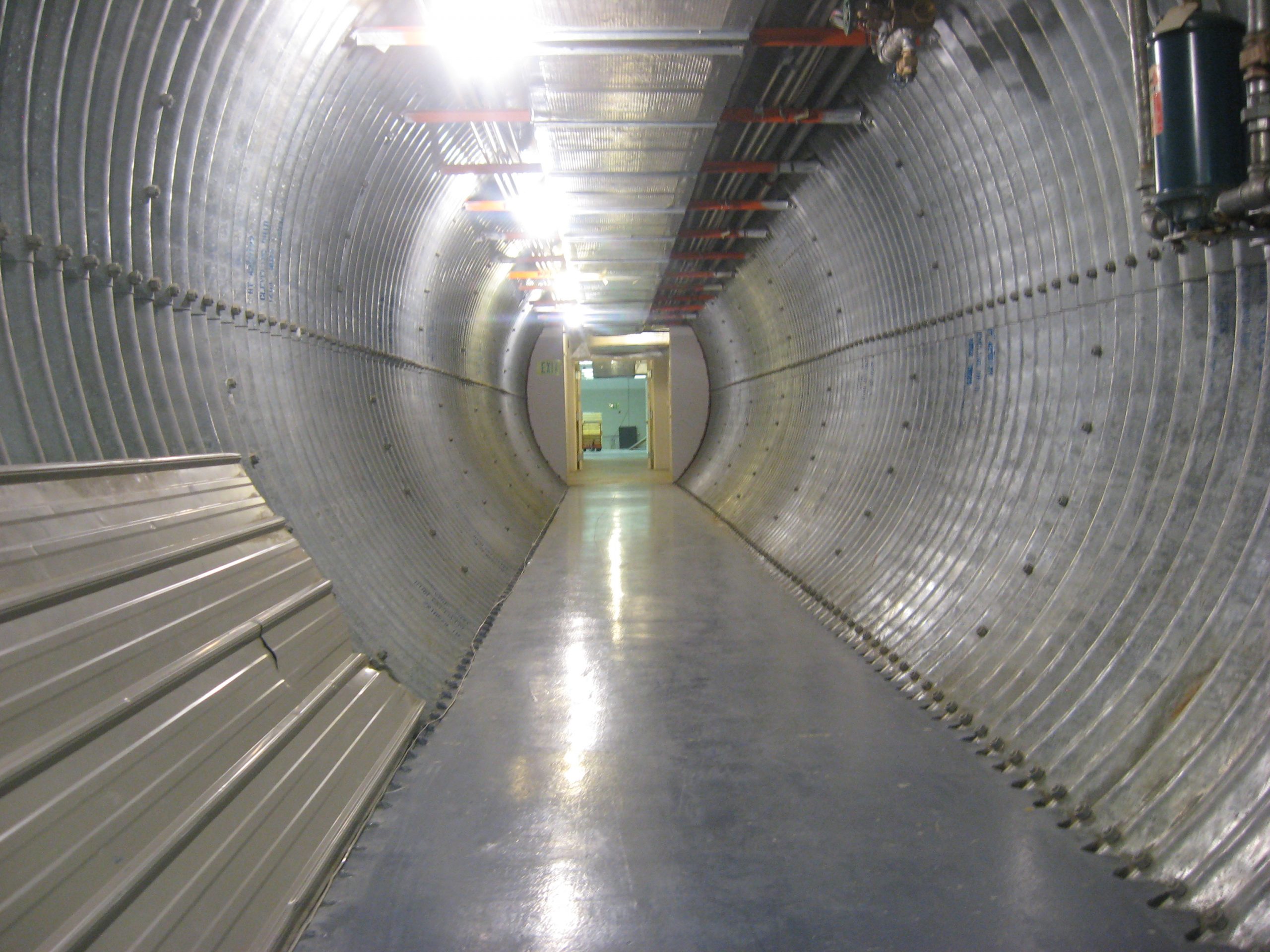In early February, Cynthia Kelly and Mark Donaldson of the Atomic Heritage Foundation had the opportunity to visit two sites associated with the Cold War history of Hanford, WA. The first was the Nike Missile Site, located near Rattlesnake Mountain. Once a large series many of underground bunkers, today two bunkers remain near Rattlesnake Mountain, connected by an underground tunnel, as pictured on the left. tunnelThe site was constructed in 1955 and housed Nike Ajax anti-aircraft missiles designed to shoot down Soviet bombers. At its peak, the site may have had as many as twenty Ajax missiles and eight surface launchers. In the 1950s, the underground launch building was divided into two designated areas. The missiles ready to launch were in the north area, with a small personnel room with all the controls for raising and lowering the elevators, selecting the missiles to be launched and manually firing the missile.
In 1961, as the creation of the intercontinental ballistic missile (ICBM) made nuclear-armed bombers a secondary threat, the missiles were removed from these sites.. However, while most of the bunkers were demolished, this one instead became the emergency relocation center for high-level Hanford personnel and community members in the early 1970s. It was stocked with bunk beds, a freezer, and various provisions necessary for survival underground. Then, in the aftermath of the Chernobyl nuclear accident in 1986, the bunker became an emergency control center for the Hanford Site until, designed to respond to any accidents or environmental incidents. A whiteboard used to coordinate this emergency control, pictured below, still hangs on the wall.
In 1997, after plutonium production at Hanford had ceased, access to the bunker was granted to a group of physicists from the University of Washignton and UC Berkeley. They were seeking an isolated facility in which to perform experiments on gravity. Specifically, they were seeking to precisely measure the gravitational constant, or “G,” a mathematical value which measures the gravitational attraction between objects with mass. They built a large apparatus to measure the behavior of a laser beam at almost -273 degrees Celsius. The experiments were so sensitive to gravitational interference that several tons of lead weights had to be placed near the apparatus in order to compensate for the gravitional pull of the nearby mountains. Their experiments have been ongoing since that date, and the researchers recently calculated the value of G with ten times more accuracy than the best previous measurements.
However, all that may end on September 1, 2011, as the site is on the Department of Energy’s list for demolition. The Atomic Heritage Foundation will work with local officials and nonprofit groups to determine whether that deadline can be postponed to give DOE officials greater time to consider the historic significance of the site and the value of preserving it future generations. The Rattlesnake Nike Site is a relic of the Cold War that tells a many-layered story. It should be preserved as one of the battle emplacements of the Cold War much as the German gun emplacements on the banks above the beaches of Normandy have been preserved as a testament to the D-Day invasion of World War II.
Cindy also took a tour of the 300 area, which was the fuel manufacturing area at Hanford from the Manhattan Project onwards. Virtually nothing in this area has been preserved; virtually all of the buildings have been demolished, and most of the activity in the area is focused on the nearby massive landfill called the Environmental Restoration Disposal Facility (ERDF), which houses low-level waste from the Hanford site.
One of the most notable landmarks in the 300 area is the 309 building, a test reactor that was key in developing fuel for commercial nuclear reactors. The reactor was topped by a massive dome, which stood out in the skyline of the Hanford complex, and was painted many different colors over the decades of the reactor’s operations. Earlier this year, the iconic dome of the 309 building was removed. The dome still sits in the 300 area, as picture on the left, awaiting its eventual demolition.
Cindy was also allowed to see the Plutonium Finishing Plant, or PFP. The PFP was constructed in 1949 to convert the plutonium created at Hanford into a metal form that was usable in weapons, a task that had previously been performed at another location. Because of the large amount of plutonium stored in the complex, even after its closure security at PFP was extremely high and access was restricted to only essential personnel. In 2009, it was announced that the last plutonium had been shipped away to the Department of Energy’s Savannah River Site, and the high security at the facility was discontinued. Cindy’s visit was a rare opportunity to see this historical site that only a couple hundred visitors have been able to see. It is currently being decontaminated and destroyed, with demolition expected to be completed by 2016. There is still hope that some of the history found at PFP will be preserved for future visitors. Colleen French, Government Affaris Program Manager at the Department of Energy at Hanford, has made it clear that she hopes to preserve artifacts from PFP, including control panels and other equipment. The preservation of artifacts, when the sites themselves cannot be saved, allows for visitors to still experience a portion of these historic sites firsthand.
Click here for a full slideshow of pictures from these historic sites.





